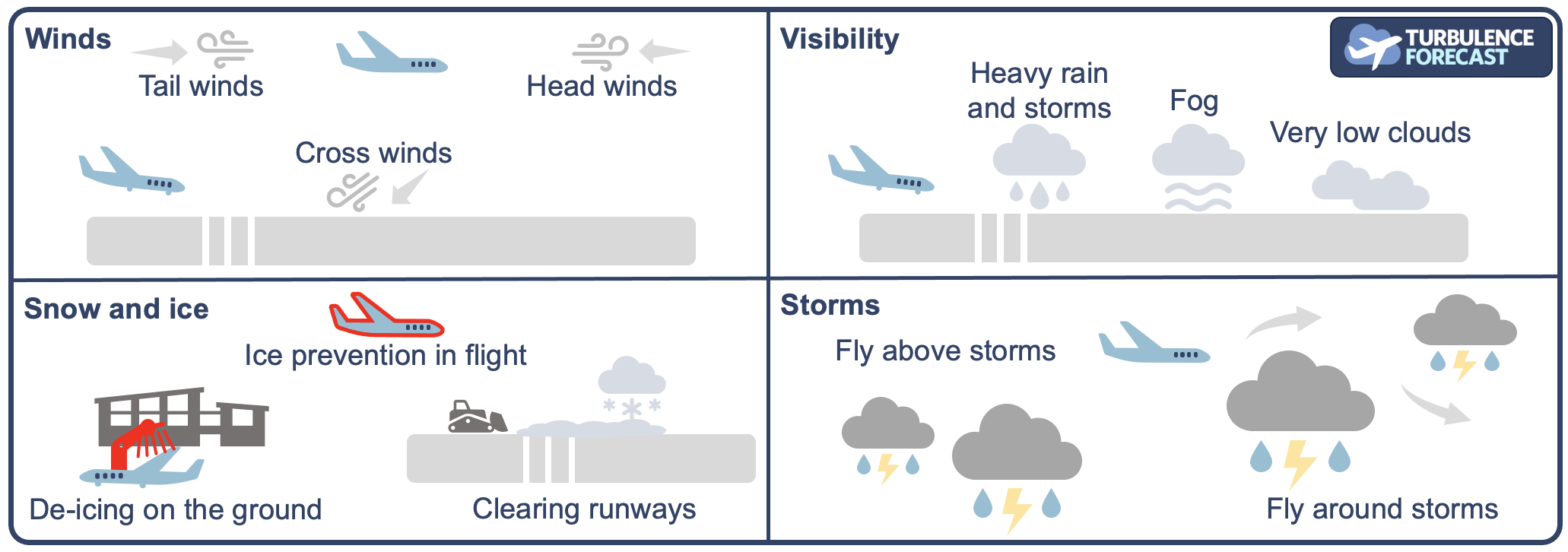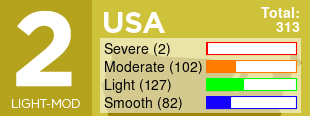Are you an Android developer and love the site? Contact us
updated (Apr 14, 2024)

(c) Turbulence Forecast 2023
What types of weather conditions are most relevant to flying?
Updated November 14, 2023
While planes seem to avoid a lot of the conditions that affect us on the ground such as rain, snowy roads, hail, and so on, atmospheric weather conditions are crucial factors for flight planning and flying. And flights have to get off the ground and back down, so the weather at the airport and to and from the cruising altitude is also relevant. Let’s look at the most important weather impacts on flight.
Winds
There are two types of winds that affect flying, surface winds and winds at flight altitudes. For both, wind direction and wind speed are crucial information for weather forecasters, flight planners, and pilots. On the surface, winds are important in determining in which direction a plane uses a given runway. Planes take off and land into the wind as much as possible, as headwind reduces the length of runway that they need. When winds or gusts run perpendicular to the runway, they are called crosswinds. Pilots orient the plane in such a way that it can land in crosswinds, but airports might close runways to smaller planes if conditions are not safe. Runways are generally built to be most practical for the prevailing winds at a given location.
In the air, the most important winds relevant to flying are the jet streams crossing our globe from west to east. They directly impact the time it takes to get from Point A to Point B, either making a route faster due to tail winds, or slower due to head winds. Jet streams also contribute to turbulence when planes have to cross them. Trade winds and lower-level winds also impact flights, especially while the plane is crossing through flight levels where those winds are prevalent. Other weather events such as storms and fronts also create winds that can reach the altitudes of commercial planes, although often commercial flights are able to fly above bad weather.
Storms
Private and commercial planes avoid flying through thunderstorms and other stormy weather conditions, and pilots are trained to navigate around storms. While planes are equipped to withstand lightning strikes, it’s not something that pilots want to experience. Pilots also fly routes to avoid strong turbulence around and in significant weather areas. Sometimes, planes have to cross cloudy and rainy patches to reach their cruising altitude or while landing. In these cases, you might experience some turbulent conditions on the way up to or down from cruising altitude. If conditions on the ground are not safe, planes will not be allowed to take off or land. If they are scheduled to land and already in the air close to the destination airport, pilots will either be instructed to fly circles, called a holding pattern, in a safe location and wait until a storm has moved out of the area, or they will be diverted to a different airport.
Ice and snow
Commercial airliners have redundant systems to keep the airplane free of ice as it flies through extremely cold temperatures at high altitudes. Heat from the jet engines is used to keep flight surfaces free of ice crystals. If there is ice or snow on the ground, special anti-icing equipment and procedures will make sure that your plane is cleared of snow and ice before you take off. Most airports that are located in places of the world that experience a lot of snow and ice are equipped to clear runways fast and manage even serious snow events. However, there might be delays as runways are prepared and planes de-iced before take-off.
Visibility
Commercial flights are equipped to fly in low-visibility conditions, as advanced equipment provides pilots a constant way to determine where they are at any given time. For most commercial airports, systems are in place to allow taking off and landing even in low visibility and rainy, foggy, and cloudy weather conditions. However, if the adverse conditions and visibility drop too low, airports, just like in the case of strong winds or storms, will halt take-offs and landings temporarily until conditions improve.


